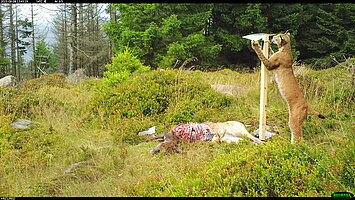Wildlife carcass
Leaving of wild animal carcasses in the landscape – Testing in the example of national parks
Animal carcasses are true hotspots of biological diversity and the foundation for a variety of organisms, from bacteria and fungi to top predators—not to mention the broad spectrum of carrion-associated insects. Examining the fate of carrion in the natural landscape is all the more important, as even in national parks within the framework of wildlife management, biomass in the form of hunted animals is removed without realizing the gap it leaves in the natural cycle.
To learn more about the ecologically significant habitat of carrion and the as yet insufficiently researched interactions among its visitors, the project 'Leaving Wild Animal Carcasses in the Landscape – Testing in the Example of National Parks' was initiated.
15 German national parks are participating as partners with the project sponsor University of Würzburg in the BfN funding project to test the retention of wildlife carcasses in the landscape.
The project goal is to, for the first time across all national parks in different major landscapes – from mountains to low mountain ranges to marine habitats – systematically investigate how carrion is utilized in various ecosystems by vertebrates, insects, and microorganisms. This aims to expand awareness of process protection as a crucial topic within the perception of national parks.
The five-year development and testing project, funded by the Federal Ministry for the Environment, Nature Conservation and Nuclear Safety (BMUV), consists of a main project and scientific monitoring. In the main project, 8 naturally deceased or fatally injured roe deer carcasses, no longer suitable for human consumption, will be left in random locations within the protected areas each year for a period of three years.
In a so-called 'block design,' six blocks (three in summer and three in winter) consisting of three sub-areas each are set up in a characteristic habitat type. One sub-area serves as a control without carrion, one sub-area has a roe deer carcass placed as a ubiquitous type of cadaver, and in the third sub-area, a specific animal species for a larger habitat is placed, such as red deer in the Bavarian Forest National Park. Wild boar carcasses are not used due to the African Swine Fever (ASP) issue.
Within the scope of the project, a scientific investigation is conducted to determine the types of organisms present on the carcass. Large scavengers are captured using camera traps, insects are collected using pitfall traps, and fungi and bacteria are documented and genetically analyzed through swabs. The study focuses on identifying the optimal conditions for carrion availability to optimize the impact on the diversity of carcass visitors across different protected areas. Simultaneously, awareness on the topic of 'death in the forest' is raised through continuous public outreach efforts in press, radio, television, websites, and social media.
At the end, recommendations for management in national parks and natural landscapes should be possible. A knowledge and results transfer across Germany's wilderness areas is a major concern and goal for all partners involved in the project.
Duration
2022-2027
Funded by

Media coverafge:
Pressemitteilung Universität Würzburg "Was Sterben für die Natur bedeutet"








